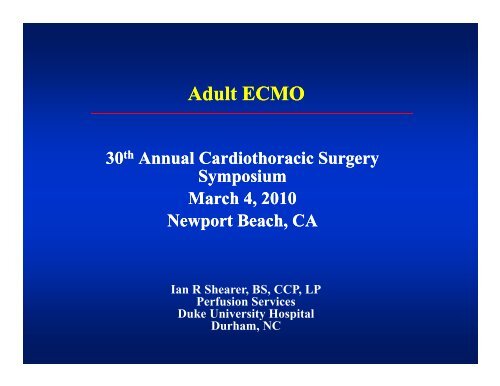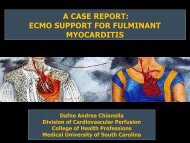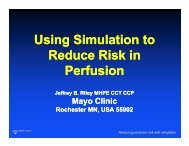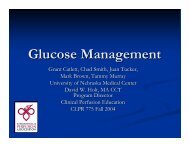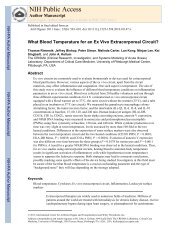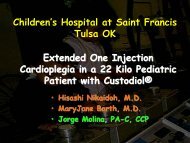Adult ECMO - Perfusion.com
Adult ECMO - Perfusion.com
Adult ECMO - Perfusion.com
Create successful ePaper yourself
Turn your PDF publications into a flip-book with our unique Google optimized e-Paper software.
<strong>Adult</strong> <strong>ECMO</strong><br />
30 th Annual Cardiothoracic Surgery<br />
Symposium<br />
March 4, 2010<br />
Newport tB Beach, CA<br />
Ian R Shearer, BS, CCP, LP<br />
<strong>Perfusion</strong> Services<br />
Duke University Hospital<br />
Durham, NC
Learning gObjec Objectives –<strong>Adult</strong> <strong>ECMO</strong><br />
At the end of this lecture, the participant p<br />
will have<br />
gained a greater understanding of the following:<br />
• Background on adult respiratory distress syndrome<br />
• Techniques associated with <strong>ECMO</strong><br />
• Clinical i l benefits and <strong>com</strong>plications<br />
• New trends with technology<br />
There are no financial or professional relationships to be disclosed.<br />
Most devices utilized for <strong>ECMO</strong> are off label/standard of care.
History of <strong>ECMO</strong><br />
1953 Gibbon 1 st successful use of CPB<br />
1967 Kolobow developed spiral coil membrane<br />
1972 Hill 1 st successful adult <strong>ECMO</strong><br />
1976 Bartlett 1 st successful neonatal <strong>ECMO</strong><br />
1979 NIH Study<br />
1989 ELSO established<br />
<strong>ECMO</strong> is indicated d when the patient t has an acute,<br />
potentially reversible, life-threatening form of respiratory<br />
failure which is unresponsive to conventional therapy.
Why <strong>ECMO</strong>?<br />
Respiratory failure<br />
ARDS<br />
Pneumonia (bacterial or viral)<br />
Multiple trauma<br />
Massive blood transfusions<br />
Aspiration pneumonitis<br />
Chemical pneumonitis<br />
Acute pancreatitis<br />
Near drowning<br />
Smoke inhalation<br />
Legionnaire’sdisease<br />
Reactive Airway disease<br />
Status asthmaticus<br />
Cardiac Failure<br />
Post bypass<br />
Myocarditis<br />
Cardiomyopathy<br />
Bridge to transplant<br />
Rescue/resuscitation
ARDS<br />
ARDS describes the clinical and radiographic<br />
manifestations i of acute direct or indirect pulmonary<br />
inflammatory states.<br />
The focus of infection or tissue injury establishes a systemic<br />
inflammatory response which initiates the ARDS<br />
process.<br />
The pulmonary endothelium is injured through the release<br />
of vasoactive mediators, proteases and toxic oxygen<br />
radicals. Initiating gp<br />
phase lasts several hours.
ARDS<br />
Exudative phase – progression of injury to interstitium and<br />
alveolar cells, capillary leak, formation of hyaline<br />
membranes. Edema leading to decreasing lung <strong>com</strong>pliance<br />
and intrapulmonary shunting.<br />
Proliferative (regenerative) phase – gradual reduction of<br />
inflammatory process, proliferation of type II<br />
pneumocytes. Fibrosis starts. Continued interstitial<br />
edema.<br />
Fibrotic phase – deposition of collagen in interstitial spaces<br />
and in collapsed alveolar spaces.<br />
Self limiting with rapid recovery or if severe and<br />
prolonged leads to largely irreversible lung injury.
ARDS<br />
Mortality related to organ failure (NIH Study 1980)<br />
Age 12-65<br />
Age > 65<br />
n mortality<br />
n mortality<br />
Pul failure only 162 40% 59 69%<br />
Pul + 2 organs 103 74% 44 91%<br />
Pul + 3 organs 74 80% 32 95%<br />
Overall 490 61% 196 81%<br />
ECLS in Critical Care<br />
Zwischenberger, Bartlett<br />
1995
Experience with ECLS for pulmonary<br />
support in severe ARF<br />
Site<br />
n survival<br />
Marburg 130 48%<br />
Milan 89 45%<br />
Paris 43 44%<br />
Ann Arbor 40 45%<br />
Berlin 28 61%<br />
Stockholm 26 35%<br />
ECLS in Critical Care<br />
Zwischenberger, Bartlett<br />
1995
<strong>Adult</strong> <strong>ECMO</strong> Inclusion Criteria<br />
• REVERSIBLE disease process<br />
• Refractory to “max” conventional therapy<br />
• High risk of mortality (> 80-90%)<br />
• Absence of severe intracranial pathology<br />
• Absence of uncontrolled bleeding/severe<br />
coagulopathy
<strong>Adult</strong> <strong>ECMO</strong> Inclusion Criteria<br />
• Oxygenation Index: (FiO 2 x MAP)/PaO 2<br />
OI > 40<br />
• Duration of ventilation<br />
<strong>Adult</strong> <strong>ECMO</strong> Exclusion Criteria<br />
Contraindication to systemic anticoagulation<br />
(except surface –coatings)<br />
Underlying severe immunodeficiency<br />
Neurologic devastation<br />
Unwitnessed/prolonged cardiac arrest<br />
Limitations of life support<br />
Limited life expectancy
ELSO Registry Jan 2010
ELSO Registry Jan 2010
ELSO Registry Jan 2010
Conventional vs Alternative Circuits<br />
Silicone membrane<br />
oxygenator<br />
high resistance<br />
requires CO2 flush<br />
Non-coated<br />
Good air-trapping<br />
Roller vs Centrifugal Pump<br />
Bladder w/ shunt?<br />
Slow setup<br />
Large prime volume<br />
Long term ?<br />
Prone to clotting<br />
Difficult to change out<br />
Hollow fiber oxygenator<br />
Centrifugal pump head<br />
Coated Surface (heparin, other)<br />
Bladder?<br />
Alternative bridge<br />
Rapid setup<br />
Low prime<br />
Short term/long term<br />
Easy to change out
Evolution of <strong>ECMO</strong><br />
Stasis in development despite emerging technologies<br />
1983 1989 1996 2004
Duke <strong>Adult</strong> <strong>ECMO</strong> 2002<br />
Console<br />
Circuit
Hemolytic Characteristics of Three<br />
Commercially Available Centrifugal Blood<br />
Pumps<br />
D. Scott Lawson, BS, CCP, Richard Ing, MB, BCh, FCA(SA), Ira M. Cheifetz, MD,<br />
Rich Walczak, BS, CCP, Damian Craig, MS, Scott Schulman, MD, Frank Kern, MD,<br />
Ian R. Shearer, BS, CCP, Andrew Lodge, MD, James Jaggers, MD<br />
Pediatr Crit Care Med 2005 Vol. 6, No. 5
Methods<br />
• Ex-vivo experiment using heparinized, fresh bovine<br />
whole blood.<br />
• Two test runs for each of the four blood pump were<br />
achieved on three consecutive days for a total of six test<br />
runs for each of the four pumps (n = 24). The testing<br />
order of the pumps was randomized.<br />
Lawson et al<br />
Pediatr Crit Care Med 2005 Vol. 6, No. 5
Bench top Study
Mean NIH values in mg/100L<br />
70.00<br />
60.00<br />
* p value < 0.05<br />
*<br />
61.1717<br />
50.00<br />
40.00<br />
NIH<br />
34.50<br />
33.00<br />
30.00<br />
29.67<br />
20.00<br />
10.00<br />
0.00<br />
Revolution Rotaflow BP-80 Roller pump
Maquet QUADROX - Blood Flow<br />
De-airing<br />
membrane<br />
e<br />
Luer port<br />
pre chamber<br />
blood in<br />
blood out
QUADROX AND QUADROX D - MEMBRANE<br />
STRUCTURES<br />
Microporous membrane<br />
Diffusion membrane<br />
pore size max.
Maquet Quadrox D Oxygenation<br />
System Features & Benefits<br />
FDA approved for 6 hours<br />
Low priming volume of 250 ml<br />
Low membrane surface area 1.8 m²<br />
Flow range 0.5lpm – 7lpm<br />
Very high transfer rate of O 2 and CO 2<br />
Most efficient integrated heat exchanger on the market<br />
Oxygenator with lowest pressure drop on the market<br />
Very easy de-airing due to integrated hydrophobic de-airing membrane<br />
Unique squared and symmetrical design<br />
Standardized Safeline or Bioline Treatment of the membrane<br />
High predictability and reliability of performance factors<br />
Maquet/AG, Maquet-Inc. 2006. Technical data brochure
Duke <strong>Adult</strong> <strong>ECMO</strong> 2007
Duke <strong>Adult</strong> <strong>ECMO</strong> 2007
<strong>Adult</strong> <strong>ECMO</strong><br />
Cannulation Strategies<br />
VV<br />
RIJ(23F Fr) )t to RFV(19F Fr)<br />
RFV (long 21 Fr) to RIJ (or LIJ)<br />
percutaneous eous approach when possible<br />
“lowest flow to achieve highest arterial sat %”<br />
requires native cardiac output<br />
VA<br />
RIJ to RCA (or LCA or Axillary)<br />
FV to FA<br />
RA to Ao<br />
avoid total bypass of lungs<br />
danger of emboli<br />
need to vent heart in asystole
<strong>Adult</strong> <strong>ECMO</strong> Management<br />
“Gentilation” (FiO 2 < 40%, Press 30/20 torr, rate 6/min,<br />
PEEP 5-10 torr)<br />
Venous O 2 sats 80-90%, arterial O 2 sats 80-95%<br />
Anticoagulation 160-180180 sec, 120-150 150 sec if bleeding<br />
Hct > 30% VA, > 35% VV<br />
Plt > 75,000/mm 3 , > 100,000 if bleeding<br />
PTT > 50-70 sec, Fib > 100-200 mg/dL<br />
Bridge, oxygenator management<br />
Urine output 100-300 ml/hr, hemofiltration<br />
Infection prevention
<strong>Adult</strong> <strong>ECMO</strong><br />
Termination of <strong>ECMO</strong><br />
Improvement in lung <strong>com</strong>pliance, ABG’s, Chest X-Ray<br />
Extensive hemorrhage (12 L/day for 1 day, 6 L/day for 2 days)<br />
Uncontrolled ET blood loss (> 200 ml/hr for > 3 hr)<br />
Time on support<br />
Indicators of reversibility of ARDS unclear<br />
Futility – ethical and legal problems
Duke <strong>Adult</strong> <strong>ECMO</strong> Experience 12/94-12/0912/09<br />
Venous-Arterial<br />
Venous-Venous<br />
V-A<br />
V-V<br />
Respiratory 28 37<br />
Cardiac 71 0<br />
Total 97 37
Duke <strong>Adult</strong> <strong>ECMO</strong> 12/94 – 12/09<br />
Diagnosis<br />
Total<br />
Redo-CAB<br />
5<br />
Lung Tx 54 Heart-Lung<br />
2<br />
VAD 12 CABG 6<br />
CPR 23 Heart Tx 7<br />
PE 2 PVR 4<br />
ARDS 8 Viral CM 3<br />
Ao Dissect 4 Other 4
Duke <strong>Adult</strong> <strong>ECMO</strong><br />
<strong>Adult</strong> <strong>ECMO</strong><br />
Cases<br />
27<br />
24<br />
21<br />
18<br />
15<br />
12<br />
9<br />
6<br />
3<br />
0<br />
1993<br />
1994<br />
1995<br />
1996<br />
1997<br />
1998<br />
1999<br />
2000<br />
2001<br />
2002<br />
2003<br />
2004<br />
2005<br />
2006<br />
2007<br />
2008<br />
2009<br />
Year<br />
Each <strong>ECMO</strong> requires 24/7 coverage and removes 3 call personnel<br />
each day to staff. Each <strong>ECMO</strong> lasts an average of 4-6 days.
Improved Results Treating Lung Allograft Failure With<br />
Venovenous Extracorporeal Membrane Oxygenation<br />
Methods: 512 patients underwent lung transplantation from<br />
April 1992 to July 2004. 23 (4.5%) patients required <strong>ECMO</strong><br />
2° PGF unresponsive to conventional treatment. 15 (65%)<br />
treated with VA <strong>ECMO</strong>, while 8 (35%) underwent VV<br />
<strong>ECMO</strong>.<br />
Results: 8/15 (53%) of VA were successfully weaned from<br />
<strong>ECMO</strong>. Only 1 long term survivor. 8/8 (100%) of VV were<br />
successfully weaned from <strong>ECMO</strong>, with 7/8 (88%) surviving<br />
> 30 days.<br />
Hartwig et al<br />
Ann of Thor Surg<br />
2005; 80: 1872-8080
Improved Results Treating Lung Allograft Failure With<br />
Venovenous Extracorporeal Membrane Oxygenation<br />
Complications<br />
Renal failure (ARF) 16<br />
Neurologic catastrophes 8<br />
Sepsis 5<br />
Hemorrhage 10<br />
VA <strong>ECMO</strong> recipients incurrred 30/39<br />
<strong>com</strong>plications. Most <strong>com</strong>plications for VV<br />
<strong>ECMO</strong> involved ARF, but by discharge,<br />
mean creatinine was 0.9.<br />
Hartwig et al<br />
Ann of Thor Surg<br />
2005; 80: 1872-8080
Lung Transplant Survival<br />
N = 12<br />
V V <strong>ECMO</strong> (updated)<br />
58%<br />
V V <strong>ECMO</strong><br />
N = 8<br />
88%<br />
V A <strong>ECMO</strong><br />
7%<br />
N = 15<br />
0% 10% 20% 30% 40% 50% 60% 70% 80% 90% 100%
<strong>ECMO</strong> Support After Percutaneous Coronary<br />
Intervention For Acute Myocardial Infarction<br />
PCI has evolved as an important treatment for patients who present with<br />
AMI associated with cardiogenic shock.<br />
Surgical revascularization not ideal treatment option due to established<br />
infarct and iatrogenic coagulopathy.<br />
Surgical LVAD not an ideal choice since LV recovery is difficult to<br />
predict and inadequate time to evaluate patient.<br />
Methods: Study period from June 2008 to September 2009. Nine<br />
consecutive patients treated with <strong>ECMO</strong> following PCI.<br />
Summary: Emergency <strong>ECMO</strong> may be used as a bridge to further clinical<br />
treatments. Can be rapidly established and achieves hemodynamic<br />
stability and normalization of end organ perfusion with no major<br />
<strong>com</strong>plications.<br />
Piacentino et al<br />
submitted to JACC 2010
<strong>ECMO</strong> in Post PCI Shock<br />
Piacentino et al<br />
submitted to JACC 2010
<strong>ECMO</strong> in Post PCI Shock<br />
Piacentino et al<br />
submitted to JACC 2010
<strong>ECMO</strong> in Post PCI Shock<br />
Piacentino et al<br />
submitted to JACC 2010
Methods<br />
UK-based multicenter trial. 180 adults randomized to receive<br />
conventional ventilation or referred for <strong>ECMO</strong>. Eligible patients<br />
18-65 yr. Usual exclusion criteria.<br />
Results<br />
68 (75%) actually received <strong>ECMO</strong>. 63% (57/90) survived <strong>ECMO</strong><br />
to 6 months without disability <strong>com</strong>pared to 47% (41/87) with CVM.<br />
p=0.03<br />
Referral to <strong>ECMO</strong> treatment led to gain of .03 quality-adjusted-life<br />
years at 6 mo follow-up.<br />
Peek et al<br />
Lancet 2009<br />
Oct:374; 1351-63
Swine Flu H1N1<br />
H1N1 Differs from “Typical” ARDS<br />
Incidence of alveolar<br />
obstruction/peripheral airway disease<br />
Extremely rapid progression of<br />
hypoxemia<br />
Incidence of secondary bacterial<br />
infection<br />
More refractory to “standard” therapies<br />
Predilection for healthy teens/young<br />
adults
In the recent Australia/New Zealand outbreak, 201<br />
patients with confirmed or suspected H1N1 were<br />
treated in 15 <strong>ECMO</strong> centers. 68 patients who<br />
failed conventional measures were placed on<br />
<strong>ECMO</strong>, with a 79% recovery/survival at time of<br />
reporting.<br />
ANZ <strong>ECMO</strong> <strong>ECMO</strong> Influenza Investigators<br />
JAMA Vol 302 No. 17, Nov 4, 2009
Duke H1N1 Experience e Fall 2009<br />
62% 75% 76% 94%<br />
Norfolk et al, Crit Care Med, submitted.
Response se to demand d for additional <strong>ECMO</strong> capacity<br />
c
Duke <strong>ECMO</strong> Program 10/09<br />
• Multidisciplinary leadership meetings<br />
• Decision i to move forward<br />
– 8 wks to formally launch an adult respiratory<br />
<strong>ECMO</strong> program in the MICU<br />
– Expand from 3 to an 8 bed center (not incl adult<br />
CT unit)<br />
• Physician, administrative and financial support<br />
• Equipment-need need to design a simple, less expensive,<br />
less labor intensive system<br />
• Personnel – training and education
Duke <strong>ECMO</strong> lite 2009
A New Miniaturized System for Extracorporeal<br />
Membrane Oxygenation in <strong>Adult</strong> Respiratory Failure<br />
Mthd Methods: 60 consecutive patients t (Apr 2006-Dec 2008) with life<br />
threatening respiratory failure. Utilization of a “new”<br />
miniaturized veno-venous venous device.<br />
Results: Rapid increase of PaO 2 /FiO 2 from 64 (48-86)torr 86)torr to 120<br />
(84-171) torr<br />
Decrease of PaCO 2 from 63 (50-80) torr to 33(29-39) 39) torr<br />
(p
Alternative pumps for adult <strong>ECMO</strong><br />
Thoratec Levatronics VAD<br />
CardiacAssist Inc<br />
Tandem Heart VAD
Successful Treatment of Peripartum<br />
Cardiomyopathy y With Extracorporeal Membrane<br />
e<br />
Oxygenation<br />
• 24 yr female developed HF within 4 months of delivery of<br />
child.<br />
• Intubation, ti inotropic i support, IABP<br />
• Use of <strong>ECMO</strong> with Quadrox D (Bioline) and CentriMag<br />
centrifugal pump, coated tubing, coated cannulae<br />
• 11 days of support, successfully weaned.<br />
• Discharged one month later with EF of 30%, 5 month<br />
follow-up; RV normal size, EF 47%<br />
Palanzo et al<br />
<strong>Perfusion</strong> 2009; 24: 75-7979
Avalon Dual Lumen Cannula<br />
Sizes 13, 16, 19, 20, 23, 27, 31 Fr
<strong>Adult</strong> <strong>ECMO</strong><br />
Summary<br />
Limited clinical experience<br />
Resource intensive<br />
Equipment/circuit improvements<br />
Rapid deployment preparedness<br />
Expanding applications<br />
Role for the perfusionist
Questions?


